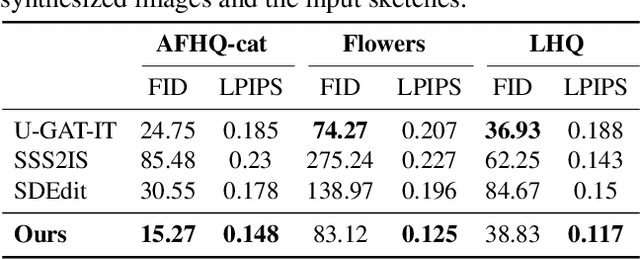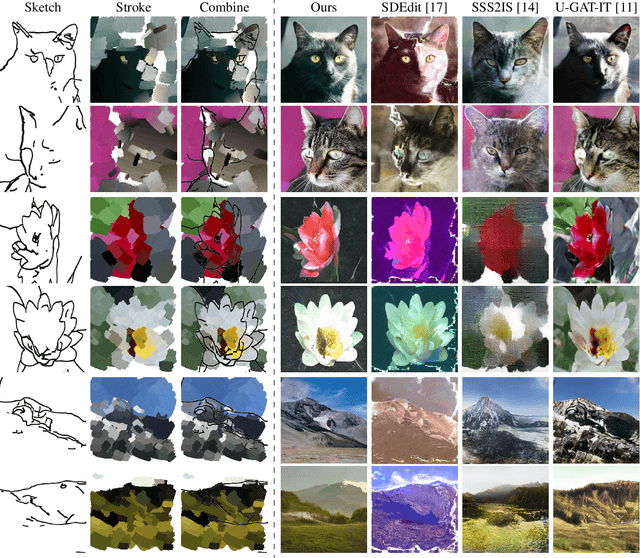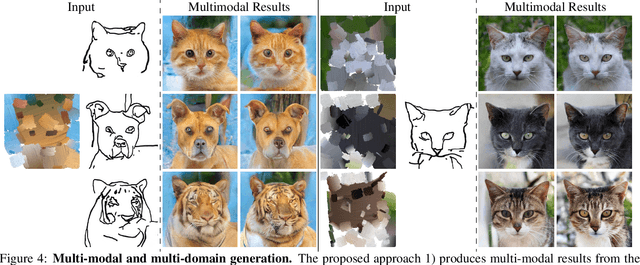Shin-I Cheng
Label-free Neural Semantic Image Synthesis
Jul 01, 2024Abstract:Recent work has shown great progress in integrating spatial conditioning to control large, pre-trained text-to-image diffusion models. Despite these advances, existing methods describe the spatial image content using hand-crafted conditioning inputs, which are either semantically ambiguous (e.g., edges) or require expensive manual annotations (e.g., semantic segmentation). To address these limitations, we propose a new label-free way of conditioning diffusion models to enable fine-grained spatial control. We introduce the concept of neural semantic image synthesis, which uses neural layouts extracted from pre-trained foundation models as conditioning. Neural layouts are advantageous as they provide rich descriptions of the desired image, containing both semantics and detailed geometry of the scene. We experimentally show that images synthesized via neural semantic image synthesis achieve similar or superior pixel-level alignment of semantic classes compared to those created using expensive semantic label maps. At the same time, they capture better semantics, instance separation, and object orientation than other label-free conditioning options, such as edges or depth. Moreover, we show that images generated by neural layout conditioning can effectively augment real data for training various perception tasks.
Adaptively-Realistic Image Generation from Stroke and Sketch with Diffusion Model
Sep 01, 2022



Abstract:Generating images from hand-drawings is a crucial and fundamental task in content creation. The translation is difficult as there exist infinite possibilities and the different users usually expect different outcomes. Therefore, we propose a unified framework supporting a three-dimensional control over the image synthesis from sketches and strokes based on diffusion models. Users can not only decide the level of faithfulness to the input strokes and sketches, but also the degree of realism, as the user inputs are usually not consistent with the real images. Qualitative and quantitative experiments demonstrate that our framework achieves state-of-the-art performance while providing flexibility in generating customized images with control over shape, color, and realism. Moreover, our method unleashes applications such as editing on real images, generation with partial sketches and strokes, and multi-domain multi-modal synthesis.
Vector Quantized Image-to-Image Translation
Jul 27, 2022



Abstract:Current image-to-image translation methods formulate the task with conditional generation models, leading to learning only the recolorization or regional changes as being constrained by the rich structural information provided by the conditional contexts. In this work, we propose introducing the vector quantization technique into the image-to-image translation framework. The vector quantized content representation can facilitate not only the translation, but also the unconditional distribution shared among different domains. Meanwhile, along with the disentangled style representation, the proposed method further enables the capability of image extension with flexibility in both intra- and inter-domains. Qualitative and quantitative experiments demonstrate that our framework achieves comparable performance to the state-of-the-art image-to-image translation and image extension methods. Compared to methods for individual tasks, the proposed method, as a unified framework, unleashes applications combining image-to-image translation, unconditional generation, and image extension altogether. For example, it provides style variability for image generation and extension, and equips image-to-image translation with further extension capabilities.
 Add to Chrome
Add to Chrome Add to Firefox
Add to Firefox Add to Edge
Add to Edge